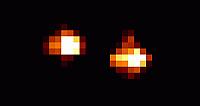| THE ING NEWSLETTER | No. 5, October 2001 |
|
|
SCIENCE |
|
|
|
| Previous: | The Planetary Nebula Spectrograph Succesfully Commissioned | Up: | Table of Contents | Next: | First Light on the New Small Fibre Module of Autofib2/WYFFOS |
Other available formats: PDF
NAOMI News
C. Benn (ING), R. Ostensen (ING), R. Myers (Univ. of Durham), T. Gregory (ING) and A. Longmore (ATC)
NAOMI, the WHT's adaptive-optics unit, is currently offered to observers with the IR imager INGRID. Performance predictions were given in the March 2001 ING Newsletter, and updates can be found on the ING web page, at http://www.ing.iac.es /Astronomy/instruments/naomi/
Much progress was made during
NAOMI's recent commissioning run in May/June. The AO loop was closed on
guide stars as faint as V=13, dithered observations were achieved without
opening the loop (by moving the telescope and guide-star pickoff mirror
in tandem), and a new control gui was implemented, allowing observing
to be carried out routinely by ING staff.
 |
Figure 1. This 0.5-arcsec double star, R=11, was selected from the Palomar Sky Survey (on which it is unresolved) as the guide star for NAOMI observations of a nearby QSO. The wavefront sensor took this double image in its stride, and the delivered FWHM on the above 30-sec H-band exposure is 0.16 arcsec. [ JPEG | TIFF ] |
NAOMI is optically and electronically much more stable than in the past, and it is now normal to observe for a whole night without having to repeat the afternoon calibration of the mirror shape. As usual, unexpected events (a devastating hacker attack, failure of the x-stage motor on the deformable mirror, and accidental rotation of one of the off-axis paraboloids) ate into the nights available, but for the first time NAOMI/INGRID service observing was attempted (25 proposals were submitted).
Performance with faint guide stars was found to be degraded by the lack of baffling around the guide-star pickoff mirror, allowing each cell on the wavefront sensor to see ~20 square arcsec of sky. A baffle is being installed.
The high (~100%) emissivity
in K band has now been traced mainly to surfaces in the Nasmyth derotator
and in the (NAOMI-specific) foreoptics in INGRID. Replacements for both
are being investigated. Observing in H and J bands is not affected.
In September, NAOMI's performance
in the optical (R, I bands) was characterised on sky. In reasonable seeing,
NAOMI typically reduced the FWHM by a factor of nearly 2, and an example
of this spectacular performance is shown on the front
cover. This bodes well for deployment of the integral-field spectrograph,
OASIS, with NAOMI in late 2002. Significant correction was obtained for
guide stars down to R=14. Galaxies will be the principal science targets
of OASIS, and the AO loop was successfully closed on the nuclei of several,
including M31 and NGC1068.
Performance in the IR (J, H, K bands) is not yet well characterised, and one of the goals for 2002A is to map performance as a function of guide-star magnitude, band, radius from guide star, and natural seeing (a large parameter space). Another important goal is commissioning of a mode in which information is binned up on the wavefront sensor, allowing ~1 mag fainter guide stars to be reached, and thus increasing sky coverage (but with poorer correction).
Commissioning of the coronographic
feed to the science detectors (INGRID, OASIS) will take place early in
2002.
Email contact: Chris Benn (crb@ing.iac.es)
| Previous: | The Planetary Nebula Spectrograph Succesfully Commissioned | Up: | Table of Contents | Next: | First Light on the New Small Fibre Module of Autofib2/WYFFOS |
| GENERAL | SCIENCE | TELESCOPES AND INSTRUMENTATION | OTHER NEWS FROM ING | TELESCOPE TIME |